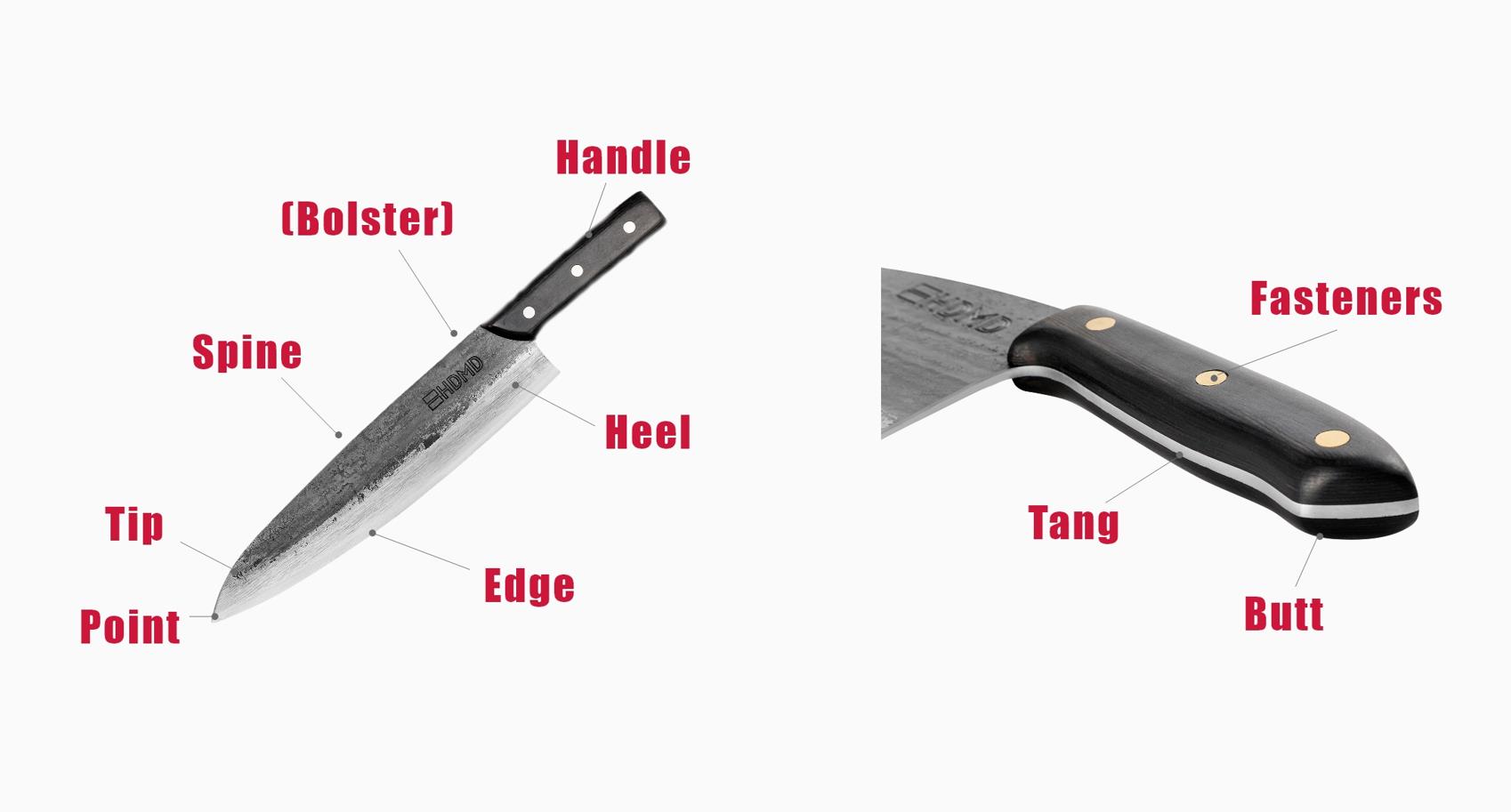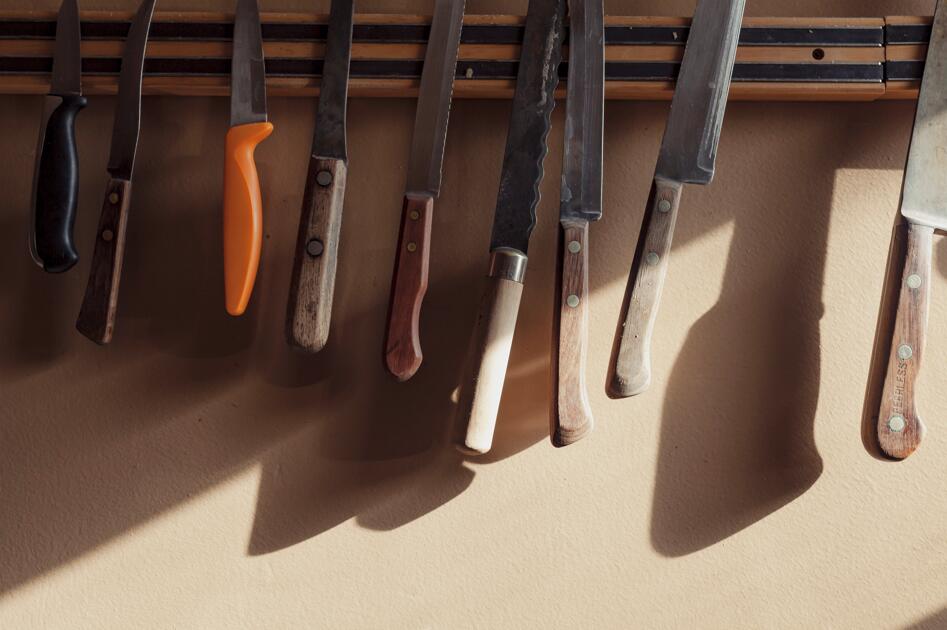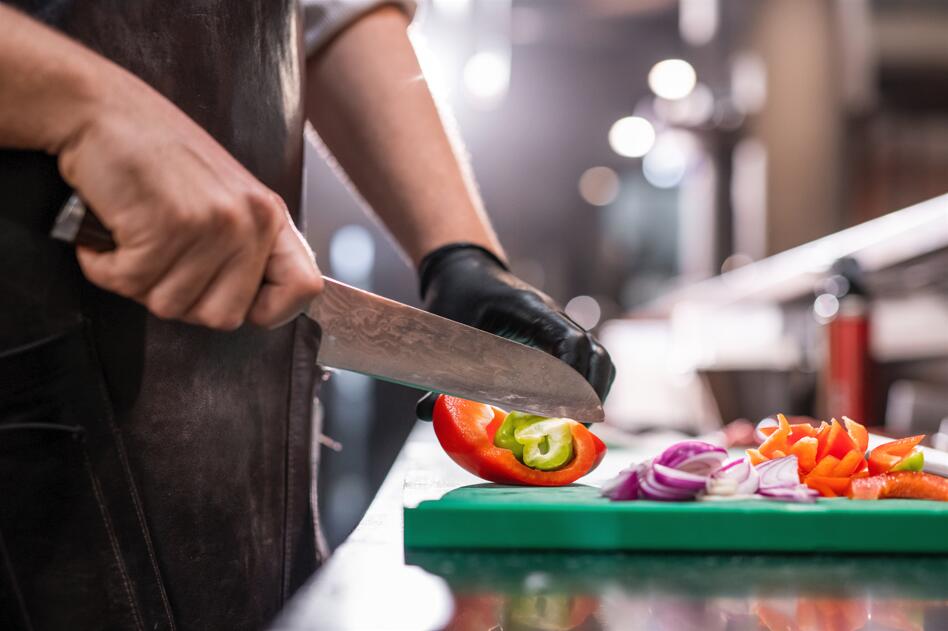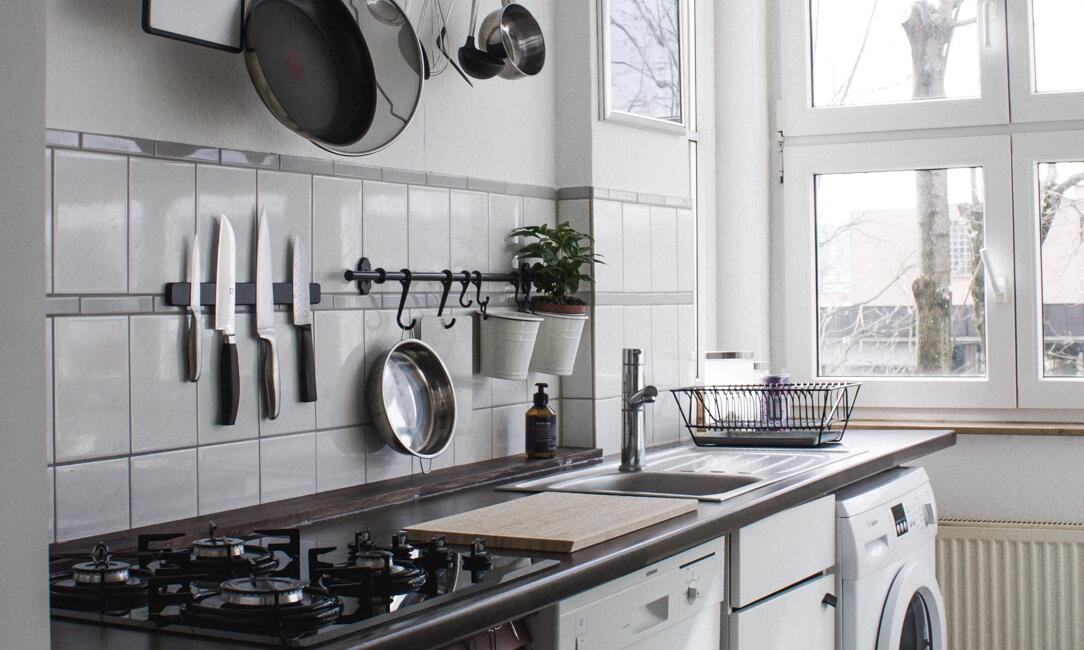The international cutlery arena swears by German knives. This is because they offer durability, versatility and aesthetics that hardly a few have managed to come close by. If you’re looking for a good quality, durable knife that will last you years to come, you should definitely invest in a German knife.
Speaking of knives, the only country that is dominating the cutlery landscape alongside Germany is the Japanese. This article aims to enlighten readers about German knives, how they differ from Japanese knives, as well as other important German knife information.
Table of contents
What is a German knife?
German knives, also known as Western style knives, are typically characterized by wider blades, softer steel, full tang and a bolster. They also feature symmetrical blade grinds, curved edges and rounded blade profiles and can be used for cutting, slicing, dicing and mincing fruits, vegetables, meat and even bone.
Parts of a German knife

- Tip and point: The edge and spine of a knife form to make the point whereas the tip is the part that is at the forward portion of the knife and includes the knife.Most western style knives typically sport “drop points” characterized by convex spines curving downwards from the handle to the point.
- Edge: The edge is that part of the knife where two sides of the knife meet in a point, running the length of the blade. Most German knives feature curved blade edges that have been sharpened on both sides known as a double-beveled blade. The curved blade allows easier rocking motions.
- Spine: The spine is the thicker, top blade edge that runs from the point to the handle. German knives generally sport thicker spines to allow for heavy duty tasks.
- Heel: The end of the blade is the heel. This is the part just before the handle. German style knives usually have pronounced heels to help cut through tough ingredients such as carrots or nuts. Pronounced heels offer some space between the hand and blade so the user does not cut himself when using the knife.
- Bolster: The bolster is the part directly in front of the knife handle where it meets the blade. German knives usually incorporate thick bolsters to allow added strength to the blade as well as protection for fingers from the heel during heavy work.
- Tang: The portion of the blade extending into the handle is called tang. Most German style knives incorporate full tangs that provide durability and balance.
What makes German knives famous?
German knives are treasured by chefs all over the world. Featuring thick blades, double-bevels and bolstered handles, these knives offer the sturdiness and heft that allows them to handle all sorts of cutlery tasks without breaking down or chipping.
German knives often features stainless steel. It was widely used because it provides the ease of maintenance and resistance to corrosion. Other types of steel such as Carbon steel can also be found in the market, but not as popular.
Handpicked for you
True cutting power in the palm of your hand
German knife varieties

- Chef knife The chef knife is an all-purpose, versatile kitchen tool with varying blade sizes of 8 to 12 inches. Made from the finest German steel, the blades are deep and curved stretching till the curved edge to allow performing various tasks such as mincing and chopping onion to handling other fruits, vegetables, and even meat.
- Utility knife Smaller than a chef knife, the utility knife is a medium-sized knife (4.5″-6″) with a narrow blade and scalloped edge that is great for peeling, slicing, and carving fruits and vegetables.
- Paring knife A paring knife is a small yet robust tool ranging from 2.5″ to 4″, that is great for precision based tasks such as peeling and cutting up fruits and vegetables.
- Boning knife Ideally 3″ to 6″, boning knives feature narrow blades and sharp tips that allow easy removal of fish, poultry, and even meat bones.
- Bread knife Bread knives have blades that are slightly curved or straight with a serrated edge that is ideal for slicing bread, bagels and similar items.
- Steak knife These German steel blades, typically of 4.5”, have a fine edge that allows cutting through steaks with superior ease.
Difference between German knives and Japanese knives
You must know the features that set German and Japanese knives apart before buying one. The primary difference between the two arises from hardness and edge retention, which ultimately makes them part ways in durability as well as function.
It must be noted here that technological and manufacturing advancements are increasingly minimizing the differences between the two resulting in hybrid knives. Regardless, here are the differences that mainly set them apart:
Knife steel
German knives are made out of softer steel with a Rockwell rating of 56-58. This stainless steel often contains chromium, which not only lowers the Rockwell scale rating but also allows resistance to rust and corrosion.
Moreover, German knives are more durable than Japanese ones and can resist chips and cracks during tough jobs. Also, softer steel makes such knives easy to sharpen. One drawback to softer steel, however, is that it doesn’t hold an edge longer and requires honing and sharpening often.
Japanese knives contain steel which is comparatively harder, with a Rockwell rating of 60-63. Harder steel, even though brittle, is capable of holding edges longer. Sharper knives allow for more precision work but may chip or break more easily if misused.
Blade profile
You will notice German knives to feature a characteristic curve from the knife bolster stretching all the way to the tip. This wide, curved blade profile facilitates a rocking action that is best used for chopping and mincing tasks.
On the other hand, Japanese knives are characterized by straighter blade profiles that allow them to make intricate, precision based cuts.
Bevel
The blade bevel determines the degree of a knife’s sharpness. The slight angle that you find on one or both sides of a knife blade running down to the edge is called bevel.
German knives typically feature a double bevel, which means that the knife is sharpened and grounded on both sides from the spine of the knife blade till the edge. The bevel is about 17-22 degrees on each side that creates razor sharp edges for handling a wide array of tasks.
German and western style knives feature wider bevels to allow overall mass and weight of the knife blade with ample strength such that they can handle tough ingredients. They are also easier to use by both right and left handed users.
Japanese knives typically feature a single bevel that creates a sharper edge of 12-16 degrees. This narrow acute angle allows precision cuts with minimal damage to the food, and also allows perseverance of both taste and texture.
Knife weight

German knives are more robust and durable than their Japanese counterparts. For this reason, they utilize more steel in their construction which contributes to the knife weight. The two main areas where German knives occupy more steel than Japanese ones are the tang and bolster.
Tang
You will notice that German knives often feature a full tang construction. This implies that the knife blade in a German knife extends all the way into the butt of the knife handle. Full tangs create more balanced, stable and durable knives that in turn allow tough tasks to be handled with ease.
On the other hand, Japanese knives are often seen to have partial tangs. This is because they are designed to handle precision cuts and require a light weighted knife for them. A lightweight knife can only be designed if less steel is used in its construction.
Since partial tang knives have weight that is distributed towards the handle top, it allows the user to make controlled movements.
Bolster
Most German knives have thick bolsters in them. This is the part between the handle and knife blade that allows resting your fingers and thumb while you make those cuts and blows. Not only do they contribute to the weight and balance of the knife, but also allow protecting the fingers by keeping them away from the knife blade.
Japanese knives usually don’t have full tangs, or a bolster. The absence of the bolster in Japanese style knives allows your hand to be closer to the blade in order to make controlled cuts and movements.
Knife handle
The handle of the knife determines the extent to which cutlery tasks can be performed with ease. Typically, they are judged based on knife handle material and design.
German knives typically sport a range of synthetic handles which allow users to express their sense of style and personal identity. Since these handles are engineered, they are more durable and feature a number of different benefits.
These knives feature curves in their handle to support a comfortable hold. Also, the tang in German knives has scales that makes them easier to hold. Rivets fasten the knife scales to the tang. Knife scales are the handle materials that are fastened onto the knife handle with the help of rivets or any other adhesive.
On the other hand, Japanese knives are largely found to have wooden handle materials such as ebony or magnolia. Such handles are often octagonal or circular in shape and don’t feature handle contours. This is why these handles are not the most comfortable and need practice to use.
Moreover, you will notice that the knife tang is not visible in Japanese knives as they are covered with knife scales.
Functionality

German and Japanese knives differ in their blade profiles and constructions, which in turn impacts upon how they are used.
Since German knives are more durable and robust, they can handle tough tasks and ingredients with ease. Whether it is slicing fish or meat, de-boning, carving fruit or any other task, German knives can handle them all. Their versatility and durability is what they are famous for.
Meanwhile, Japanese knives do not offer the same durability that German knives do. Therefore, they are only apt for lighter precision cutting tasks on fruits, vegetables, and boneless meat. There are specific Japanese kitchen knives that are designed for specific task performance.
| Factor | German | Japanese |
| Steel | Softer | Harder |
| Bevel | 17-22 | 12-16 |
| Bolster | Yes | No |
| Handle | Ergonomic grip; full tang | Traditionally cylindrical; partial tang |
| Blade | Slight curved edge; wide-angled tip | Straighter edge; acute tip |
| Use | Versatile; can handle tough tasks | Precision cutting |
How to choose a German knife

In order to choose the best German knives for your cutlery needs, you must consider the following factors and choose one that best suits your cutlery style:
Type of knife
The type and number of knives you require depend on your skills and inclination towards the culinary arts. You don’t have to choose a wide number of knife pieces though. Wisely selecting a moderate number will help you with almost all of your kitchen tasks.
90% of your kitchen tasks can be done with a chef’s knife, a paring knife and a slicer.
Construction
German knives have been incorporating proprietary types and varieties of steel that grant them differing levels of durability, sharpness and edge retention. These steel types are complimented with full tangs as well as riveted handles and bolsters that provide the best balance and weight.
Look for German knives that are well-constructed and provide you with the right balance of durability, sharpness as well as edge retention.
Handle
German knives also boast the best kinds of handles to help achieve an edge from their competitors. Different bolster designs are integrated in their knives that allow them to stand out. These bolsters also guard your fingers and provide extra strength.
Here are three main bolster types that German knives incorporate:
- Full bolster: Knives that have a full bolster provide the maximum amount of durability and integrity. Moreover, they help your fingers from slipping. Be careful though, as you will not be able to use the blade’s full length and will face difficulty sharpening.
- Half bolster: Half bolsters incorporate sloped designs for providing considerable protection to the fingers whilst allowing using the full length of the knife blade.
- No bolster: Knives that have no bolster give users a hard time performing tough tasks due to a lack of extra strength and durability that full bolsters offer. However, the knife blade can be used fully as well as sharpened easily.
Maintenance
Last but not the least, it all comes down to how you maintain your knife. Caring for your knives will allow them to last you for years to come. Always hand-wash your German knives and pat dry. Next, store them in proper knife storage spaces such as blocks, strips, or sheaths etc. Sharpen your knives straight away when you feel they have gotten dull.
German knife brand recommendations
Solingen, Germany is considered the mecca of knives. If you’re looking for a good quality German knife, consider buying from one of these German brands:
- Zwilling J.A Henckels: Based in Solingen, this is one of the oldest knife making brands specializing in kitchen knives for both domestic and professional use.
- Wusthof: Wusthof is one of the oldest family-owned knife making German brands.
- Boker: From scissors and pocket knives to all sorts of kitchen cutlery, this German brand provides a wide variety of German blades.
- Gude: Gude is a German brand that caters to customized needs of chefs all over the world.
- Messermeister: Although a competitively younger brand, traditional knife forging methods are employed by this California based knife maker.
FAQs
Are German knives better than Japanese knives?
Both German and Japanese knives are revered in the culinary world due to their unique craftsmanship and quality. Choosing one over the other depends on personal preferences and needs only. If you’re looking for a durable and versatile knife for all-purpose tasks, go with German knives. However, if your knife will only be used for precision cutting, it’s better to go with a Japanese knife that is ultra-sharp, light-weight, and easy to maneuver.
Why choose German knives?
German knives offer three main benefits. First, they have greater durability due to the proprietary steel blends used in their manufacturing. Second, they boast greater edge retention so the user spends less time sharpening them. And last but not the least, they are less prone to rust and corrosion.
What are the three main German knives that will suffice in a kitchen?
The three main kitchen knives that can handle all sorts of tasks are the chef knife, the serrated knife, and the paring knife. The chef knife is an all-rounder tool that can perform a wide array of tasks. The serrated knife or bread knife can handle both hard and soft foods. Lastly, the paring knife can handle smaller, precision tasks in the kitchen.
In conclusion
From the above discussion, it can be safe to conclude that German knives are one of the best knives in the world. Buying from a German knife brand will definitely help in all your kitchen tasks and last you for a good time. Therefore, you may go ahead and buy that German knife now!












